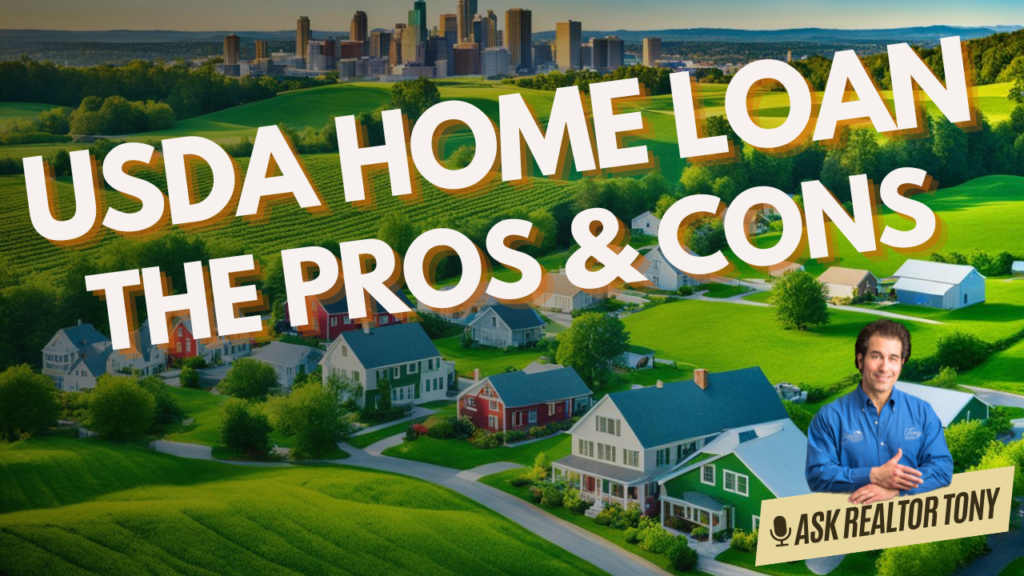
USDA Home Loan Pros and Cons Revealed
How would you like to buy a home with no money down and a really competitive interest rate? You might ask, is it possible? Realtor Tony is here to give you a resounding, oh yeah! Have you heard about USDA home loans? Maybe you have but are unsure if they are the right choice for you? In this comprehensive article, we will uncover the USDA home loan pros and cons.
This loan is brought to you by the US Department of Agriculture. The USDA Home Loan is specifically designed to assist low to moderate-income families in purchasing properties in rural areas. Does the property have to be in a rural area? No, in fact there are suburban areas across the USA that are eligible. By exploring the advantages and disadvantages of USDA loans, I aim to help you make an informed decision about whether this type of loan can fulfill your homeownership dreams.
Additionally, we will delve into USDA rural development loan reviews. This will provide insights from borrowers who have experienced the program firsthand. Their experiences will shed light on the realities of utilizing USDA home loans and help you gain a better understanding of what to expect. Let’s get started.
Key Takeaways:
- The advantages of the USDA are low or no down payment requirements. This will make homeownership more affordable for low to moderate-income families.
- These loans often come with competitive interest rates. Allowing borrowers to save money over the life of the loan.
- USDA loans do have geographical and property eligibility requirements. Which limits the areas where you can purchase and the types of properties that qualify.
- Income and employment standards must be met to be approved for a USDA loan. Ensuring borrowers have the financial means to repay their mortgage.
- Reading USDA rural development loan reviews can provide valuable insights into the experiences of other borrowers and help you make a more informed decision.
An Introduction to USDA Home Loans
In this section, we will provide an introduction to USDA home loans. We will explain what a USDA loan is and how it is different from other types of home loans. Additionally, we will provide an overview of the USDA Rural Development Guaranteed Housing Loan program. We will discuss the benefits of USDA loans, such as low or no down payment requirements and lower interest rates. Plus any drawbacks or limitations that borrowers should be aware of.
No to Low Down Payment
USDA home loans are mortgage assistance programs offered by the US Department of Agriculture. These loans aim to help low-to-moderate-income families purchase properties in rural areas. One of the key advantages of USDA loans is the opportunity to achieve homeownership with little or no down payment. It’s an attractive option for individuals who may not have substantial savings for a large upfront payment.

Low Interest Rate = More House
Another significant benefit of USDA loans is the relatively low interest rates compared to other mortgage options. Lower interest rates translate to more affordable monthly mortgage payments. As well as enabling borrowers to save money while buying more house. Additionally, USDA loans do not require private mortgage insurance (PMI) for low or no down payments. This will further reduce the overall cost of homeownership while reducing monthly housing costs.
Drawbacks and Limitations
However, it’s important to consider some drawbacks and limitations associated with USDA loans. Firstly, these loans are only available to borrowers interested in purchasing properties in designated rural areas. The definition of rural areas may vary, so it’s crucial to check the USDA eligibility map to determine if the desired property qualifies for a USDA loan. Secondly, USDA loans have income restrictions, and borrowers must meet specific income requirements to be eligible. This aspect aims to ensure that the program benefits individuals with limited financial resources. Lastly, USDA loans may have longer processing times compared to traditional home loans due to the additional verification process required.
USDA Loan Eligibility Requirements
In order to qualify for a USDA loan, borrowers must meet certain eligibility requirements. These requirements include:
Income and Employment Standards for USDA Loan Approval
USDA loans are designed to assist low- to moderate-income families in purchasing homes in rural areas. To be eligible for a USDA loan, borrowers must meet the income and employment standards set by the USDA. These standards are based on the borrower’s household size and vary depending on the location of the property. It is important to note that borrowers must have a stable source of income and verifiable employment history to qualify for a USDA loan.
Credit Score Requirements
Credit score requirements for USDA loans may vary among lenders, but a minimum credit score of 640 is typically required. Lenders will also review the borrower’s credit history to assess their creditworthiness. It is important for borrowers to maintain a good credit score and demonstrate responsible credit management to improve their chances of qualifying for a USDA loan.
Geographical and Property Eligibility
The USDA has specific geographical eligibility requirements for USDA loans. This program is intended to promote homeownership in rural areas. With that said, properties in urban or suburban areas are generally not eligible. However, in recent years, the USDA has broadened the eligible areas. To determine if a property is eligible for a USDA loan, borrowers can use the USDA’s online map tool. Additionally, the property must meet certain criteria. It must be a single-family dwelling and meet safety and livability standards.
| Eligibility Requirement | Details |
|---|---|
| Income and Employment | Meet USDA standards for income and stable employment history. |
| Credit Score | Typically require a minimum credit score of 620 – 640. |
| Geographical Eligibility | Properties in designated rural areas are eligible. |
| Property Eligibility | Properties must meet safety and livability standards. |

Understanding USDA Loan Financing Terms
I recommend consulting with a USDA-approved lender for eligibility guidance. Should you decide to apply, consult that same lender for assistance with the loan application process. Now that you understand the income and employment standards, credit score requirements, and geographical and property eligibility criteria. Let’s take a look at the numbers that matter most, the financing. This is where the USDA home loan pros and cons really come into focus.
Is there a Down Payment?
A great advantage of USDA loans is that they offer low or even no down payment requirements. In fact, USDA loans are one of the few mortgage programs that allow borrowers to finance the entire purchase price. This makes it an appealing option for homebuyers who may not have substantial savings for a down payment.
Single Family Housing Direct Home Loans are the USDA Loans you’ll want to apply for. This particular program offers Zero Down Payment and as of March 2024, a 4.5% interest rate. It’s the cream of the crop.
How much are Closing Costs?
When it comes to closing costs, USDA loans are fairly similar to other types of mortgages. Closing costs typically include fees for loan origination, appraisal, title search, credit report, and other expenses associated with the loan process. While closing costs can vary depending on the lender and location, they typically range from 2% to 5% of the loan amount. It’s important to note that buyers can negotiate with sellers to cover a portion or all of the closing costs. It’s also referred to as “Seller Concessions”. Ask your Realtor to write your offer with a credit towards closing costs.
What is the Interest Rate?
Interest rates for USDA loans are competitive with other types of mortgages. However in our present interest rate environment, the rate is much lower. The exact interest rate you qualify for will depend on factors such as your credit score, loan term, and current market conditions.
It’s always a good idea to shop around and compare interest rates. Speaking with different lenders is a way to ensure you’re getting the best possible rate. Be sure to request the “Single Family Housing Direct Home Loan“. This particular loan offers No Down Payment and as of March 2024 a 4.5% Interest rate.
By understanding the financing options available with USDA loans, you can make an informed decision. Is this type of mortgage right for you? The options of no down payment, manageable closing costs, and competitive interest rates can make the USDA loan an excellent choice. Ultimately it’s up to you but let’s continue by taking a look at the USDA home loan pros and cons.
Pros and Cons: USDA Home Loan
What are the Pros?
USDA home loans offer several advantages for potential homebuyers:
- The ability to purchase a home with no down payment, making it accessible for individuals with limited savings.
- Lower credit score requirements compared to conventional loans, allowing more people to qualify.
- Competitive interest rates, which can potentially save borrowers thousands of dollars over the life of the loan.
- No private mortgage insurance (PMI) required for low or no down payments, reducing monthly mortgage costs.
What are the Cons?
While USDA loans offer many benefits, there are some potential drawbacks to consider:
- Limited geographical eligibility, as these loans are only available for properties located in designated rural areas.
- Strict property eligibility requirements, which may limit the types of properties that qualify for USDA financing.
- Income limitations, as USDA loans are designed to assist low- to moderate-income families.
It’s important to weigh the pros and cons of USDA home loans to determine if they align with your financial situation and homeownership goals.

Comparing USDA Loan Programs to Other Mortgage Products
In this section, we will compare USDA loan programs to other mortgage products. Specifically FHA loans and conventional mortgage loans. In order to put the USDA home loan pros and cons into perspective we will evaluate the similarities and differences between these loan programs. We will review eligibility requirements, down payment options, and interest rates. This will help you make an informed decision about which option aligns best with your financial situation and homeownership goals.
FHA Loan
When comparing USDA loans to FHA loans, you’ll find both similarities and distinctions.
Some key points to consider:
- Eligibility requirements: Both USDA and FHA loans have specific eligibility criteria. While USDA loans are primarily designed for low- to moderate-income families in rural areas, FHA loans are available to a broader range of borrowers, including those in urban and suburban areas. Credit scores and income limits may vary between the two loan types.
- Down payment options: USDA loans offer the advantage of no down payment requirements, making them an attractive option for those looking to minimize upfront costs. Conversely, FHA loans typically require a minimum down payment of 3.5% of the purchase price.
- Interest rates: Both USDA and FHA loans offer competitive interest rates, but the specifics may vary depending on factors such as credit history and current market conditions. It’s essential to compare rates from different lenders to find the most favorable terms.
Overall, FHA loans provide more flexibility in terms of geographic eligibility and property types, compared to USDA loans. However, USDA loans offer the unique advantage of no down payment, making them an attractive option for individuals or families in rural areas.
Conventional Mortgage Loan
Comparing USDA loans to conventional mortgage loans will help you understand the advantages and disadvantages of each option.
Consider the following points:
- Eligibility requirements: Conventional mortgage loans generally have stricter eligibility criteria compared to USDA loans. Borrowers with stronger credit scores and higher income may find it easier to qualify for conventional mortgages.
- Down payment options: While USDA loans provide the benefit of no down payment, conventional mortgage loans often require a down payment of at least 3% or more.
- Interest rates: Interest rates for conventional mortgage loans may vary based on factors such as credit history, loan term, and market conditions. It’s crucial to shop around to find the most competitive rates.
Conventional mortgage loans offer more flexibility in terms of property types and geographic locations compared to USDA loans. However, USDA loans may be more advantageous for those seeking lower or no down payment options. Take into consideration your personal financial situation and the USDA home loan pros and cons to determine the best fit for your needs.

Insights from USDA Rural Development Loan Reviews
User Experiences and Success Stories
In this section, we will provide insights from USDA rural development loan reviews. We understand that when considering a USDA loan, it can be helpful to hear about the experiences of other borrowers. By sharing success stories, we aim to showcase the positive impact that USDA loans have had on individuals and families in rural areas.
Realtor Tony’s Story
This particular story is personal to me. As a Realtor, I helped a client in Tennessee utilize the USDA Home Loan to purchase a great house in a suburban neighborhood near Nashville. My clients dream was to own a home and she never thought it would be possible. She applied and was approved for $350k. My client went shopping and found an amazing house with a big yard. Her realtor submitted an offer and it was accepted. My client and friend is now a home owner with a 4.24% interest rate in a 7% market and she got 100% financing.
Sarah’s Story
Now, take the case of Sarah Rodriguez from Kansas. Sarah was able to purchase her dream home through the USDA loan program. She shared, “Thanks to the USDA loan, my family and I were able to find an affordable home in a rural area. It’s been a truly life-changing opportunity for us.”
By highlighting success stories, we hope to inspire and motivate readers who may be considering a USDA loan. These personal accounts provide real-world examples of how the program has helped individuals and families achieve their dreams of owning a home in rural and suburban areas.
Critical Feedback and Areas for Improvement
In addition to success stories, it is important to address any critical feedback and areas for improvement that have been raised by borrowers in USDA rural development loan reviews. By acknowledging these concerns, we aim to provide a balanced perspective and ensure readers have a comprehensive understanding of the program.
Some borrowers have expressed frustration with the lengthy approval process or encountered challenges in finding eligible properties. It is important to note that while USDA loans offer numerous benefits, there may also be limitations and specific requirements that borrowers should be aware of.
Despite these challenges, the majority of borrowers have found the USDA loan program to be a valuable resource for achieving homeownership in rural areas. By highlighting both the positive experiences and areas for improvement, we aim to present a balanced and transparent view of the program.
Conclusion of USDA Home Loan Pros and Cons
In conclusion, the pros and cons of USDA home loans have been thoroughly examined in this article. By considering the following key points, you can make an informed decision. Is this home loan the right choice for your homebuying journey?
Benefits: USDA loans offer several advantages, such as low or no down payment requirements. You will get competitive interest rates, and the absence of private mortgage insurance (PMI). These benefits can make homeownership more accessible and affordable for low- to moderate-income families.
Drawbacks: It is important to be aware of the limitations of USDA loans. These include geographical and property eligibility restrictions. Equally important, the income limitations and the extra time required for loan processing. Understanding these drawbacks will help you determine if you qualify and if the program aligns with your goals.
Ultimately, the decision to pursue a USDA home loan depends on your individual financial situation and homeownership objectives. Remember to reach out to lenders, explore other mortgage options, and consult with a financial advisor to ensure you make the best decision for your future.







